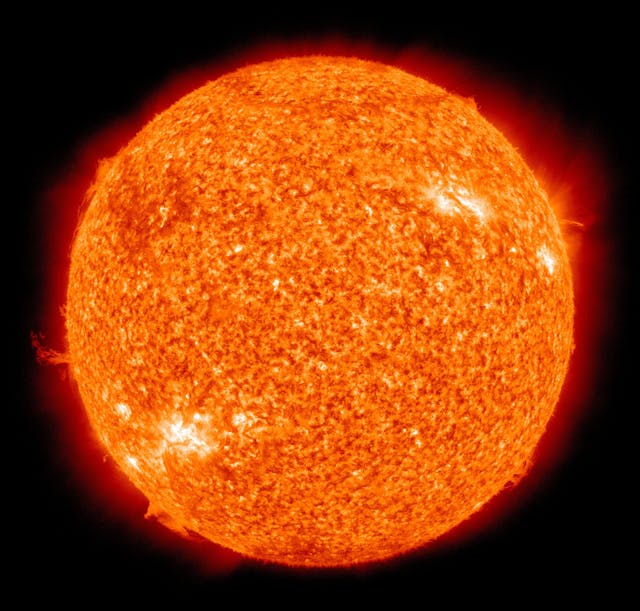
Why is the sun’s corona so hot? The corona of the sun is so much hotter than the surface of the sun because it is probably heated by waves that carry extra energy out from the sun. This is currently the most likely theory.
The corona of the sun is the outer edge of the sun’s atmosphere. It is made of plasma from hydrogen and helium. Plasma is the fourth state of matter after liquid, solid, and gas. An element becomes a plasma when it is heated to such a level that its electrons break free. The corona extends out from the sun for millions of kilometers. It is the part of the sun you can still see when there is a solar eclipse, and the main body of the sun is hidden from view. The corona is very dim, and it is hidden by the light from the sun, so we can only see it when the light from the sun has gone. It looks very much like a crown, which is where the word “corona” comes from. It is Latin for crown. You can find it in coronate, and coronet (a small crown). The corona of the sun reaches temperatures of 2 million degrees Celsius, which is thousands of times hotter than the surface of the sun. The corona has occasionally been measured at 40 million degrees Celsius.
Heat starts at the center of the sun and is made by fusion. The enormous gravity of the sun presses hydrogen atoms together until they overcome their repulsive forces and fuse, forming a helium atom. The atomic mass of one helium atom is less than that of four hydrogen atoms, and that excess mass is released as energy. The temperature at the core of the sun is almost 16 million degrees Celsius. The energy produced in the core of the sun starts to work its way out through photon radiation. The energy is produced as a photon, which travels a few millimeters and is absorbed by another atom. That atom then produces more photons, which head out in random directions. Through this process, the energy slowly heads to the surface, but it can take 170,000 years. Density decreases as the photon moves towards the surface because the pressure is decreasing. By the time the photon arrives at the surface of the sun, there are fewer atoms to trap the photon, and it is radiated out into space as heat and light. This is good for us because it means life can exist here on Earth. Because energy is being radiated out, the surface of the sun is much cooler than the center, only reaching about 5,500 degrees Celsius.
As density goes down, temperature goes down. At least, that is what should happen. If you look at our Earth, as you go up through the atmosphere, the temperature drops as the density of the air gets lower. Once you are on the edge of the atmosphere, it is very cold. This doesn’t seem to happen with the sun, though. Once you leave the surface of the sun, the atmosphere starts to get hotter. Not all of the gases in the sun are used for fusion, and a lot are lost to space. These gases form the corona, and they rapidly start to heat up, reaching millions of degrees.
There are several theories as to why this might be, but recent research has shown that the most likely cause is waves of plasma that start in the lower atmosphere and extend out to the corona. These waves are controlled by the sun’s magnetic field, and they shoot out into space. They are known as low amplitude decayless kink oscillations. They are low amplitude, which means that they do not carry a lot of energy, but they are decayless, which means that they do not lose any of that energy. It takes them a long time, but they can supply an enormous amount of energy to the gases in the corona, superheating it. Astronomers didn’t know how the energy could be applied to the corona because it is so low in density. It looks like the low amplitude waves head out in a multitude of directions, and, if given enough time, they can provide the heat. Another theory is nanoflares. The sun’s magnetic field breaks and reconnects all of the time, and every time it does, there is an impulse of energy called a nanoflare. It is possible that this is also the way that the corona is heated. It might be a case that it is a combination of the two and not one or the other.
At the far edge of the corona, it is pulled out into space and becomes the solar wind that travels right through the solar system, as far out as the Kuiper belt. If we didn’t have our atmosphere, this solar wind would wreak havoc here. And this is what I learned today.
Sources
https://scied.ucar.edu/learning-zone/sun-space-weather/corona
https://www.space.com/solar-waves-sun-corona-mysteriously-hotter-than-surface
https://www.aanda.org/articles/aa/full_html/2015/11/aa26195-15/aa26195-15.html
https://umbra.nascom.nasa.gov/spartan/the_corona.html
https://www.nature.com/articles/s41467-023-41029-8
https://en.wikipedia.org/wiki/Stellar_corona
https://spaceplace.nasa.gov/sun-corona/en/
https://scied.ucar.edu/learning-zone/sun-space-weather/surface-of-the-sun
https://www.solarcellcentral.com/how-the-sun-releases-energy.html
https://est-east.eu/?option=com_content&view=article&id=920&Itemid=622&lang=en
Photo by Pixabay: https://www.pexels.com/photo/painting-of-red-planet-87611/
